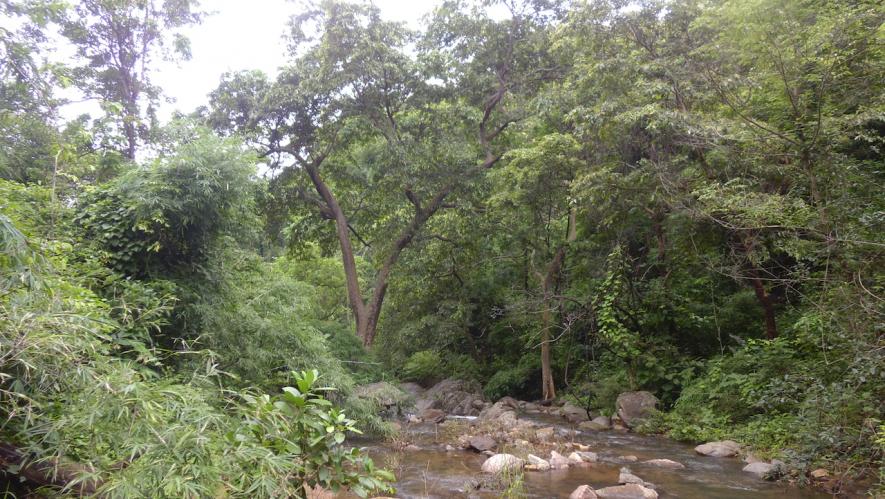India’s Forests Under Threat Due to Irresponsible Govt. Policies

Image for representational Purpose Only
On July 4, the Delhi High Court prohibited the government authorities from cutting down over 16,500 trees for the construction of residential complexes in South Delhi till July 26 and have asked the concerned departments for an explanation for the move.
For over a month, environmental activists and common people have been protesting against this “redevelopment” project. However, nearly 3,000 trees have already been felled. The World Health Organisation (WHO) has ranked Delhi as the highest polluted capital city in the world and felling a large number of trees would only worsen the city's condition.
The present government, led by Bharatiya Janata Party (BJP), has sanctioned a number of power and mining projects on the forest land in the last four years, continuing and enhancing the tradition that was already put in place by the earlier governments.
The official data, which portrayed an increase in forest cover area in recent years, has remained a reason for deforestation in the name of “development”. But the data seems far-fetched to many conservationists, scientists and international organisations.
Also Read: How to Make India's Biggest Land Reform Fail
According to Forest Survey of India (FSI), the country’s total forest cover is nearly 7,08,273 sq km or 21.5% India’s geographical area as of 2017. The survey had estimated that the forest cover had increased from 6,75,588 sq km in 2001 to 6,92,027 sq km in 2011. This is in direct contrast with the estimates by Global Forest Watch (GFW) – a project run by a partnership of the University of Maryland, Google and the World Resources Institute – which analyses satellite data to track tree loss worldwide. As per GFW, India’s forests declined from 4,90,910 in 2000 to 3,51,243 in 2010 (last published data). This striking difference between the figure by FSI and GFW is mainly due to a different definition of the ‘forest cover’ by each of them.
FSI estimates forest cover as all lands “which have a tree canopy density of more than 10% when projected vertically on the horizontal ground, within a minimum areal extent of one hectare.” This definition does not distinguish between tree species, land use or ownership. On the other hand, though the GSW’s definition of “tree cover” is similar to that of FSI’s ‘forest cover’, the former only considers vegetation that is taller than 5 metres in height. Now since the FSI includes the plantation growth under forest cover definition, the increased forest cover does not necessarily mean an increase in the quality of the forest. Both FSI and GSW use similar satellite imagery with a resolution of nearly 23.5 metres per pixel.
Officials from within the FSI have criticized the forest cover data as overestimations. For instance, in 2012, Ranjit Gill of FSI claimed that illegal felling of trees has devastated protected forests in the northeast of the country. Based on his first-hand experience, Gill alleged that the government of Meghalaya state had failed to act sufficiently on “illegal felling and coal mining” and has ravaged the region’s protected forests.
Also Read: Is the Draft National Forest Policy, 2018, an Attempt to Privatise Forests?
Apart from the flawed forest estimations, the BJP government has taken up the job of further dismantling existing environmental rules and regulations in order to serve corporate interests. Recently, the Ministry of Environment, Forest and Climate Change, after revising the earlier one, has come up with a new draft forest policy, 2018. The draft has received stringent opposition from numerous experts and civil society organisations, as they have pointed out several loopholes in the policy.
If the policy comes into existence, the government will frame new sets of rules and laws in the name of “development”. The policy continues with the same definition of “forest cover”, which means that plantations will still be considered as forests. The government has even proposed to begin “public-private partnership models” in forestlands for “increasing productivity of forests”. This move, if implemented, will eventually devastate the livelihoods of a vast population of tribals, forest and forest-fringe dwellers and numerous ethnic communities who have been dependent on forests since ages.
Also Read: ‘Management’ and ‘Productivity’ Should Not be Guiding Principles Behind the Forest Policy
The policy, according to D Raghunandan from Delhi Science Forum, threatens the very nature of forests in India in both their ecological and societal dimensions in several ways. As the policy treats forest cover and tree cover as interchangeable terms, he argues that the intention is to “promote plantation activities on the fringes and inside existing forests themselves” which will provide a significant role to the private sector.
Raghunandan says that the policy doesn’t differentiate between a mixed forest from an area with planted commercial tree species. Commercial plantations, unlike mixed forests, “cannot provide the ecological services of maintaining bio-diversity, checking soil erosion, harvesting rainwater or snowfall and recharging surface or underground water bodies.” This is also the case with carbon sequestration.
The government might be envisaging the target of reaching 33% forest cover as per Paris (Climate) Agreement signed in 2016, but if it continues with such a plantation business, it would lead towards ecological destruction and commercial exploitation.
As India has already been experiencing devastating consequences of climate change, instead of tackling the situation, the country, with unscientific environmental policies in play, is marching towards an ecological and social imbalance.
Also Read: Assault on Environmental Regulations: Reaching a Peak?
Get the latest reports & analysis with people's perspective on Protests, movements & deep analytical videos, discussions of the current affairs in your Telegram app. Subscribe to NewsClick's Telegram channel & get Real-Time updates on stories, as they get published on our website.
























